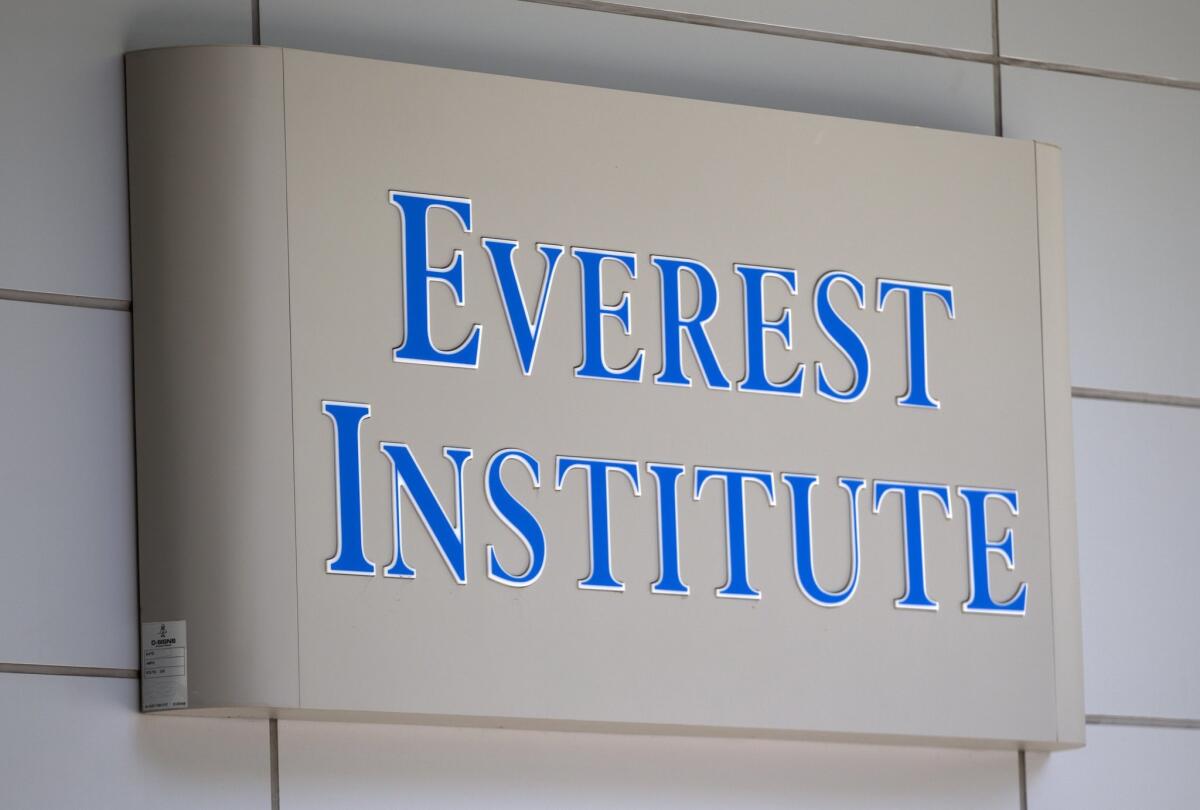Op-Ed: Cancel all Corinthian Colleges student debt

An Everest Institute sign is seen in an office building in Silver Spring, Md., in 2014. The federal government will erase portions of the debt of some of the students who attended the now-defunct Corinthian Colleges.
In February, 15 students who had attended Corinthian Colleges Inc. launched the nation’s first student debt strike. The students declared that they would no longer repay their loans on the grounds that Corinthian — a network of for-profit schools including Everest, Heald and WyoTech — had used fraudulent marketing and recruitment practices and that the credits and degrees they earned were worthless. Soon the Corinthian 15 became the Corinthian 100, and the 200. Groups such as the American Federation of Teachers and Jobs With Justice endorsed their cause.
Corinthian filed for bankruptcy in May, and the Department of Education has now announced a plan to cancel the debt of some former Corinthian students.
This is a significant victory for the strikers. It shows that the tactic of debt refusal, when strategically deployed, can get results. But the department hasn’t done nearly as much as it could, or should, to set things right.
When Education Secretary Arne Duncan revealed the debt relief plan, he blasted schools such as Corinthian for bringing “the ethics of payday lending into higher education.” These schools, Duncan said, “prey on the most vulnerable students and leave them with debt that they too often can’t repay.” Indeed, a third of Corinthian students came from families that earned less than $10,000 per year.
A close look at the fine print, however, reveals that Duncan and his staff are presenting a stopgap measure as a meaningful solution. Instead of issuing a blanket discharge to all former Corinthian students, the department offers a byzantine process that will likely leave out many students.
Most students will have to apply individually, and be required to submit transcripts and other documents that may be hard to come by because their campuses have shut down or been sold. They must also spell out what parts of a state law Corinthian violated in their particular case. These students are not lawyers, and they should not be required to do the job of a federal agency with a fleet of attorneys on staff.
Students, already drowning in debt, will soon find themselves tied up in red tape, and that’s only if they know the relief program exists in the first place. The Education Department has announced no plans to alert students about their options, even though it acknowledged to the New York Times that in past cases of college closures, only 6% of students have typically asked for debt cancellation.
It’s clear from the long trail of allegations against Corinthian that it was a “bad actor,” a term federal officials used in a meeting with strikers and organizers. The state of California has been investigating the company since at least 2007, when a last-minute settlement stopped an impending lawsuit. Since then, dozens of state and federal authorities have investigated Corinthian. The federal Consumer Financial Protection Bureau sued the company in 2014, accusing it of operating a predatory lending scheme.
But the Education Department is largely to blame for the problem of unscrupulous, for-profit schools. For decades, the government has funded billions of dollars in grants, loans and GI Bill benefits to students at these institutions. A 2012 Senate Committee found that 86% of the revenue at 15 of these publicly traded schools came from taxpayers. Corinthian alone got $1.4 billion a year — much of which flowed to conservative think tanks and public relations firms, according to investigative reporter Lee Fang.
In 2014, the Education Department accused Everest College of lying to students about job placement rates and briefly cut off federal funding to Corinthian. After the company said it could not survive even a few weeks without the public money, the Education Department continued funding Corinthian while the network sought a buyer.
The Education Department is aware that its actions in this case will set a precedent. There are other for-profit colleges that are teetering on the brink of collapse. The Securities and Exchange Commission, for instance, recently announced it was investigating ITT Tech for fraud. And in May, the Art Institutes announced it would shut down more than a dozen campuses.
It’s clear that the Department of Education does not want to be in the position of having to cancel potentially millions of student loans. But anything less would be morally unacceptable. The government makes an obscene profit from the student loan program — an estimated $110 billion over the next decade. That may be justifiable when students actually receive an education, but not when they’re defrauded. Why not divert some of the $110 billion to make scammed students whole?
According to attorneys at the National Consumer Law Center, the Education Department has the legal power to issue a broad cancellation of Corinthian loans. Reaching into its own coffers to erase the debts of the hundreds of thousands of former Corinthian students is both lawful and the right thing to do.
Astra Taylor and Ann Larson are members of the Debt Collective, which organized the student debt strike against Corinthian Colleges.
Follow the Opinion section on Twitter @latimesopinion and Facebook
More to Read
A cure for the common opinion
Get thought-provoking perspectives with our weekly newsletter.
You may occasionally receive promotional content from the Los Angeles Times.










